+ データを開く
データを開く
- 基本情報
基本情報
| 登録情報 | データベース: EMDB / ID: EMD-24095 | |||||||||
|---|---|---|---|---|---|---|---|---|---|---|
| タイトル | Anaplastic lymphoma kinase (ALK) extracellular fragment of ligand binding region 673-1025 in complex with AUG-alpha | |||||||||
 マップデータ マップデータ | Anaplastic lymphoma kinase (ALK) extracellular fragment of ligand binding region 673-1025 in complex with AUG-alpha | |||||||||
 試料 試料 |
| |||||||||
 キーワード キーワード | Anaplastic lymphoma kinase / Receptor tyrosine kinases / RTK / FAM150 / DE NOVO PROTEIN / TRANSFERASE | |||||||||
| 機能・相同性 |  機能・相同性情報 機能・相同性情報positive regulation of ERK5 cascade / ASP-3026-resistant ALK mutants / NVP-TAE684-resistant ALK mutants / alectinib-resistant ALK mutants / brigatinib-resistant ALK mutants / ceritinib-resistant ALK mutants / crizotinib-resistant ALK mutants / lorlatinib-resistant ALK mutants / MDK and PTN in ALK signaling / receptor signaling protein tyrosine kinase activator activity ...positive regulation of ERK5 cascade / ASP-3026-resistant ALK mutants / NVP-TAE684-resistant ALK mutants / alectinib-resistant ALK mutants / brigatinib-resistant ALK mutants / ceritinib-resistant ALK mutants / crizotinib-resistant ALK mutants / lorlatinib-resistant ALK mutants / MDK and PTN in ALK signaling / receptor signaling protein tyrosine kinase activator activity / regulation of dopamine receptor signaling pathway / response to environmental enrichment / transmembrane receptor protein tyrosine kinase activator activity / ALK mutants bind TKIs / swimming behavior / phosphorylation / Signaling by LTK / positive regulation of dendrite development / regulation of neuron differentiation / peptidyl-tyrosine autophosphorylation / Signaling by ALK / adult behavior / response to stress / neuron development / negative regulation of lipid catabolic process / energy homeostasis / transmembrane receptor protein tyrosine kinase activity / cell surface receptor protein tyrosine kinase signaling pathway / cytokine activity / hippocampus development / positive regulation of NF-kappaB transcription factor activity / positive regulation of neuron projection development / receptor protein-tyrosine kinase / receptor tyrosine kinase binding / Signaling by ALK fusions and activated point mutants / heparin binding / regulation of cell population proliferation / protein autophosphorylation / protein tyrosine kinase activity / regulation of apoptotic process / positive regulation of ERK1 and ERK2 cascade / receptor complex / signal transduction / protein-containing complex / extracellular space / extracellular exosome / extracellular region / ATP binding / identical protein binding / plasma membrane 類似検索 - 分子機能 | |||||||||
| 生物種 |  Homo sapiens (ヒト) Homo sapiens (ヒト) | |||||||||
| 手法 | 単粒子再構成法 / クライオ電子顕微鏡法 / 解像度: 2.27 Å | |||||||||
 データ登録者 データ登録者 | Myasnikov AG / Reshetnyak AV / Kalodimos CG | |||||||||
| 資金援助 |  米国, 1件 米国, 1件
| |||||||||
 引用 引用 |  ジャーナル: Nature / 年: 2021 ジャーナル: Nature / 年: 2021タイトル: Mechanism for the activation of the anaplastic lymphoma kinase receptor. 著者: Andrey V Reshetnyak / Paolo Rossi / Alexander G Myasnikov / Munia Sowaileh / Jyotidarsini Mohanty / Amanda Nourse / Darcie J Miller / Irit Lax / Joseph Schlessinger / Charalampos G Kalodimos /  要旨: Anaplastic lymphoma kinase (ALK) is a receptor tyrosine kinase (RTK) that regulates important functions in the central nervous system. The ALK gene is a hotspot for chromosomal translocation events ...Anaplastic lymphoma kinase (ALK) is a receptor tyrosine kinase (RTK) that regulates important functions in the central nervous system. The ALK gene is a hotspot for chromosomal translocation events that result in several fusion proteins that cause a variety of human malignancies. Somatic and germline gain-of-function mutations in ALK were identified in paediatric neuroblastoma. ALK is composed of an extracellular region (ECR), a single transmembrane helix and an intracellular tyrosine kinase domain. ALK is activated by the binding of ALKAL1 and ALKAL2 ligands to its ECR, but the lack of structural information for the ALK-ECR or for ALKAL ligands has limited our understanding of ALK activation. Here we used cryo-electron microscopy, nuclear magnetic resonance and X-ray crystallography to determine the atomic details of human ALK dimerization and activation by ALKAL1 and ALKAL2. Our data reveal a mechanism of RTK activation that allows dimerization by either dimeric (ALKAL2) or monomeric (ALKAL1) ligands. This mechanism is underpinned by an unusual architecture of the receptor-ligand complex. The ALK-ECR undergoes a pronounced ligand-induced rearrangement and adopts an orientation parallel to the membrane surface. This orientation is further stabilized by an interaction between the ligand and the membrane. Our findings highlight the diversity in RTK oligomerization and activation mechanisms. | |||||||||
| 履歴 |
|
- 構造の表示
構造の表示
| ムービー |
 ムービービューア ムービービューア |
|---|---|
| 構造ビューア | EMマップ:  SurfView SurfView Molmil Molmil Jmol/JSmol Jmol/JSmol |
| 添付画像 |
- ダウンロードとリンク
ダウンロードとリンク
-EMDBアーカイブ
| マップデータ |  emd_24095.map.gz emd_24095.map.gz | 48.6 MB |  EMDBマップデータ形式 EMDBマップデータ形式 | |
|---|---|---|---|---|
| ヘッダ (付随情報) |  emd-24095-v30.xml emd-24095-v30.xml emd-24095.xml emd-24095.xml | 31.5 KB 31.5 KB | 表示 表示 |  EMDBヘッダ EMDBヘッダ |
| FSC (解像度算出) |  emd_24095_fsc.xml emd_24095_fsc.xml emd_24095_fsc_2.xml emd_24095_fsc_2.xml | 9.7 KB 9.1 KB | 表示 表示 |  FSCデータファイル FSCデータファイル |
| 画像 |  emd_24095.png emd_24095.png | 74.8 KB | ||
| Filedesc metadata |  emd-24095.cif.gz emd-24095.cif.gz | 7.3 KB | ||
| その他 |  emd_24095_additional_1.map.gz emd_24095_additional_1.map.gz emd_24095_additional_2.map.gz emd_24095_additional_2.map.gz emd_24095_additional_3.map.gz emd_24095_additional_3.map.gz emd_24095_half_map_1.map.gz emd_24095_half_map_1.map.gz emd_24095_half_map_2.map.gz emd_24095_half_map_2.map.gz | 59.9 MB 32.1 MB 5 MB 48.6 MB 48.6 MB | ||
| アーカイブディレクトリ |  http://ftp.pdbj.org/pub/emdb/structures/EMD-24095 http://ftp.pdbj.org/pub/emdb/structures/EMD-24095 ftp://ftp.pdbj.org/pub/emdb/structures/EMD-24095 ftp://ftp.pdbj.org/pub/emdb/structures/EMD-24095 | HTTPS FTP |
-検証レポート
| 文書・要旨 |  emd_24095_validation.pdf.gz emd_24095_validation.pdf.gz | 747.4 KB | 表示 |  EMDB検証レポート EMDB検証レポート |
|---|---|---|---|---|
| 文書・詳細版 |  emd_24095_full_validation.pdf.gz emd_24095_full_validation.pdf.gz | 747 KB | 表示 | |
| XML形式データ |  emd_24095_validation.xml.gz emd_24095_validation.xml.gz | 16.4 KB | 表示 | |
| CIF形式データ |  emd_24095_validation.cif.gz emd_24095_validation.cif.gz | 21.3 KB | 表示 | |
| アーカイブディレクトリ |  https://ftp.pdbj.org/pub/emdb/validation_reports/EMD-24095 https://ftp.pdbj.org/pub/emdb/validation_reports/EMD-24095 ftp://ftp.pdbj.org/pub/emdb/validation_reports/EMD-24095 ftp://ftp.pdbj.org/pub/emdb/validation_reports/EMD-24095 | HTTPS FTP |
-関連構造データ
| 関連構造データ |  7n00MC 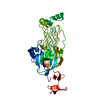 7mzwC  7mzxC 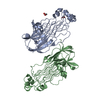 7mzyC  7mzzC M: このマップから作成された原子モデル C: 同じ文献を引用 ( |
|---|---|
| 類似構造データ | |
| 電子顕微鏡画像生データ |  EMPIAR-10930 (タイトル: Anaplastic lymphoma kinase (ALK) extracellular fragment of ligand binding region 648-1025 in complex with AUG-alpha EMPIAR-10930 (タイトル: Anaplastic lymphoma kinase (ALK) extracellular fragment of ligand binding region 648-1025 in complex with AUG-alphaData size: 10.2 TB Data #1: Unaligned multi-frame micrographs of 2:2 ALK:AugAlpha complex [micrographs - multiframe] Data #2: Aligned single-frame micrographs of 2:2 ALK:AugAlpha complex [micrographs - single frame]) |
- リンク
リンク
| EMDBのページ |  EMDB (EBI/PDBe) / EMDB (EBI/PDBe) /  EMDataResource EMDataResource |
|---|---|
| 「今月の分子」の関連する項目 |
- マップ
マップ
| ファイル |  ダウンロード / ファイル: emd_24095.map.gz / 形式: CCP4 / 大きさ: 64 MB / タイプ: IMAGE STORED AS FLOATING POINT NUMBER (4 BYTES) ダウンロード / ファイル: emd_24095.map.gz / 形式: CCP4 / 大きさ: 64 MB / タイプ: IMAGE STORED AS FLOATING POINT NUMBER (4 BYTES) | ||||||||||||||||||||||||||||||||||||||||||||||||||||||||||||||||||||
|---|---|---|---|---|---|---|---|---|---|---|---|---|---|---|---|---|---|---|---|---|---|---|---|---|---|---|---|---|---|---|---|---|---|---|---|---|---|---|---|---|---|---|---|---|---|---|---|---|---|---|---|---|---|---|---|---|---|---|---|---|---|---|---|---|---|---|---|---|---|
| 注釈 | Anaplastic lymphoma kinase (ALK) extracellular fragment of ligand binding region 673-1025 in complex with AUG-alpha | ||||||||||||||||||||||||||||||||||||||||||||||||||||||||||||||||||||
| 投影像・断面図 | 画像のコントロール
画像は Spider により作成 | ||||||||||||||||||||||||||||||||||||||||||||||||||||||||||||||||||||
| ボクセルのサイズ | X=Y=Z: 0.826 Å | ||||||||||||||||||||||||||||||||||||||||||||||||||||||||||||||||||||
| 密度 |
| ||||||||||||||||||||||||||||||||||||||||||||||||||||||||||||||||||||
| 対称性 | 空間群: 1 | ||||||||||||||||||||||||||||||||||||||||||||||||||||||||||||||||||||
| 詳細 | EMDB XML:
CCP4マップ ヘッダ情報:
| ||||||||||||||||||||||||||||||||||||||||||||||||||||||||||||||||||||
-添付データ
-追加マップ: Anaplastic lymphoma kinase (ALK) extracellular fragment of ligand...
| ファイル | emd_24095_additional_1.map | ||||||||||||
|---|---|---|---|---|---|---|---|---|---|---|---|---|---|
| 注釈 | Anaplastic lymphoma kinase (ALK) extracellular fragment of ligand binding region 673-1025 in complex with AUG-alpha | ||||||||||||
| 投影像・断面図 |
| ||||||||||||
| 密度ヒストグラム |
-追加マップ: Anaplastic lymphoma kinase (ALK) extracellular fragment of ligand...
| ファイル | emd_24095_additional_2.map | ||||||||||||
|---|---|---|---|---|---|---|---|---|---|---|---|---|---|
| 注釈 | Anaplastic lymphoma kinase (ALK) extracellular fragment of ligand binding region 673-1025 in complex with AUG-alpha | ||||||||||||
| 投影像・断面図 |
| ||||||||||||
| 密度ヒストグラム |
-追加マップ: Anaplastic lymphoma kinase (ALK) extracellular fragment of ligand...
| ファイル | emd_24095_additional_3.map | ||||||||||||
|---|---|---|---|---|---|---|---|---|---|---|---|---|---|
| 注釈 | Anaplastic lymphoma kinase (ALK) extracellular fragment of ligand binding region 673-1025 in complex with AUG-alpha | ||||||||||||
| 投影像・断面図 |
| ||||||||||||
| 密度ヒストグラム |
-ハーフマップ: Anaplastic lymphoma kinase (ALK) extracellular fragment of ligand...
| ファイル | emd_24095_half_map_1.map | ||||||||||||
|---|---|---|---|---|---|---|---|---|---|---|---|---|---|
| 注釈 | Anaplastic lymphoma kinase (ALK) extracellular fragment of ligand binding region 673-1025 in complex with AUG-alpha | ||||||||||||
| 投影像・断面図 |
| ||||||||||||
| 密度ヒストグラム |
-ハーフマップ: Anaplastic lymphoma kinase (ALK) extracellular fragment of ligand...
| ファイル | emd_24095_half_map_2.map | ||||||||||||
|---|---|---|---|---|---|---|---|---|---|---|---|---|---|
| 注釈 | Anaplastic lymphoma kinase (ALK) extracellular fragment of ligand binding region 673-1025 in complex with AUG-alpha | ||||||||||||
| 投影像・断面図 |
| ||||||||||||
| 密度ヒストグラム |
- 試料の構成要素
試料の構成要素
-全体 : hetero-tetrameric complex of anaplastic lymphoma kinase (ALK) wit...
| 全体 | 名称: hetero-tetrameric complex of anaplastic lymphoma kinase (ALK) with Augmentor alpha |
|---|---|
| 要素 |
|
-超分子 #1: hetero-tetrameric complex of anaplastic lymphoma kinase (ALK) wit...
| 超分子 | 名称: hetero-tetrameric complex of anaplastic lymphoma kinase (ALK) with Augmentor alpha タイプ: complex / ID: 1 / 親要素: 0 / 含まれる分子: all |
|---|---|
| 由来(天然) | 生物種:  Homo sapiens (ヒト) Homo sapiens (ヒト) |
| 分子量 | 理論値: 108 kDa/nm |
-分子 #1: ALK tyrosine kinase receptor
| 分子 | 名称: ALK tyrosine kinase receptor / タイプ: protein_or_peptide / ID: 1 / コピー数: 2 / 光学異性体: LEVO / EC番号: receptor protein-tyrosine kinase |
|---|---|
| 由来(天然) | 生物種:  Homo sapiens (ヒト) Homo sapiens (ヒト) |
| 分子量 | 理論値: 39.377559 KDa |
| 組換発現 | 生物種:  |
| 配列 | 文字列: GTAPKSRNLF ERNPNKELKP GENSPRQTPI FDPTVHWLFT TCGASGPHGP TQAQCNNAYQ NSNLSVEVGS EGPLKGIQIW KVPATDTYS ISGYGAAGGK GGKNTMMRSH GVSVLGIFNL EKDDMLYILV GQQGEDACPS TNQLIQKVCI GENNVIEEEI R VNRSVHEW ...文字列: GTAPKSRNLF ERNPNKELKP GENSPRQTPI FDPTVHWLFT TCGASGPHGP TQAQCNNAYQ NSNLSVEVGS EGPLKGIQIW KVPATDTYS ISGYGAAGGK GGKNTMMRSH GVSVLGIFNL EKDDMLYILV GQQGEDACPS TNQLIQKVCI GENNVIEEEI R VNRSVHEW AGGGGGGGGA TYVFKMKDGV PVPLIIAAGG GGRAYGAKTD TFHPERLENN SSVLGLNGNS GAAGGGGGWN DN TSLLWAG KSLQEGATGG HSCPQAMKKW GWETRGGFGG GGGGCSSGGG GGGYIGGNAA SNNDPEMDGE DGVSFISPLG ILY TPALKV MEGHGEVNIK HYLNCSHCEV DECHMDPESH KVICFCDHGT VLAEDGVSCI VSP UniProtKB: ALK tyrosine kinase receptor |
-分子 #2: ALK and LTK ligand 2
| 分子 | 名称: ALK and LTK ligand 2 / タイプ: protein_or_peptide / ID: 2 / コピー数: 2 / 光学異性体: LEVO |
|---|---|
| 由来(天然) | 生物種:  Homo sapiens (ヒト) Homo sapiens (ヒト) |
| 分子量 | 理論値: 14.640013 KDa |
| 組換発現 | 生物種:  |
| 配列 | 文字列: GAEPREPADG QALLRLVVEL VQELRKHHSA EHKGLQLLGR DYALGRAEAA GLGPSPEQRV EIVPRDLRMK DKFLKHLTGP LYFSPKCSK HFHRLYHNTR DCTIPAYYKR CARLLTRLAV SPVCMEDKQ UniProtKB: ALK and LTK ligand 2 |
-実験情報
-構造解析
| 手法 | クライオ電子顕微鏡法 |
|---|---|
 解析 解析 | 単粒子再構成法 |
| 試料の集合状態 | particle |
- 試料調製
試料調製
| 濃度 | 1 mg/mL | ||||||||
|---|---|---|---|---|---|---|---|---|---|
| 緩衝液 | pH: 7.4 構成要素:
| ||||||||
| グリッド | モデル: Quantifoil R1.2/1.3 / 材質: GOLD / メッシュ: 300 / 支持フィルム - 材質: CARBON / 支持フィルム - トポロジー: HOLEY | ||||||||
| 凍結 | 凍結剤: ETHANE / チャンバー内湿度: 95 % / チャンバー内温度: 283.15 K / 装置: FEI VITROBOT MARK IV 詳細: QUANTIFOIL R1.2/1/3 gold 300 mesh grids without glow-discharge, blotting time 3 sec., blotting force -5.. |
- 電子顕微鏡法
電子顕微鏡法
| 顕微鏡 | FEI TITAN KRIOS |
|---|---|
| 温度 | 最低: 96.0 K / 最高: 98.0 K |
| 特殊光学系 | エネルギーフィルター - 名称: GIF Bioquantum / エネルギーフィルター - スリット幅: 20 eV / 詳細: Gatan energy filter |
| 詳細 | SerialEM coma-free alignment |
| 撮影 | フィルム・検出器のモデル: GATAN K3 (6k x 4k) / 撮影したグリッド数: 1 / 実像数: 2498 / 平均露光時間: 4.2 sec. / 平均電子線量: 81.0 e/Å2 / 詳細: 4.2 second exposure, 70 frames, total dose 81e |
| 電子線 | 加速電圧: 300 kV / 電子線源:  FIELD EMISSION GUN FIELD EMISSION GUN |
| 電子光学系 | C2レンズ絞り径: 70.0 µm / 照射モード: FLOOD BEAM / 撮影モード: BRIGHT FIELD / Cs: 2.7 mm / 最大 デフォーカス(公称値): 1.5 µm / 最小 デフォーカス(公称値): 0.5 µm / 倍率(公称値): 105000 |
| 試料ステージ | 試料ホルダーモデル: FEI TITAN KRIOS AUTOGRID HOLDER ホルダー冷却材: NITROGEN |
| 実験機器 |  モデル: Titan Krios / 画像提供: FEI Company |
+ 画像解析
画像解析
-原子モデル構築 1
| 精密化 | 空間: REAL / プロトコル: RIGID BODY FIT |
|---|---|
| 得られたモデル |  PDB-7n00: |
 ムービー
ムービー コントローラー
コントローラー





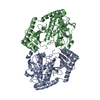
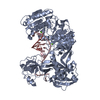

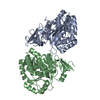
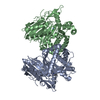
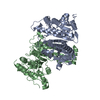
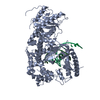

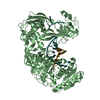

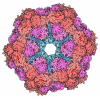



 Z (Sec.)
Z (Sec.) Y (Row.)
Y (Row.) X (Col.)
X (Col.)






























































